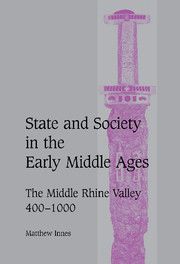Book contents
- Frontmatter
- Contents
- List of figures
- List of abbreviations
- A note on nomenclature and citations
- Acknowledgements
- Map 1 The Carolingian Rhineland
- Map 2 The Carolingian middle Rhine valley
- 1 INTRODUCTION
- 2 MONASTICISM, SPIRITUAL PATRONAGE AND SOCIAL STRUCTURE
- 3 LAND, KINSHIP AND STATUS
- 4 LOCAL POWER: COLLECTIVE ACTION, CONFLICT AND CONSENSUS
- 5 LOCALITY AND CENTRE: MECHANISMS OF EXTRACTION
- 6 POLITICAL POWER FROM THE FIFTH TO THE ELEVENTH CENTURY
- 7 CONCLUSION: STATE AND SOCIETY IN THE EARLY MEDIEVAL WEST
- List of primary sources
- Bibliography of secondary works
- Index
- Cambridge Studies in Medieval Life and Thought Fourth series
6 - POLITICAL POWER FROM THE FIFTH TO THE ELEVENTH CENTURY
Published online by Cambridge University Press: 10 July 2009
- Frontmatter
- Contents
- List of figures
- List of abbreviations
- A note on nomenclature and citations
- Acknowledgements
- Map 1 The Carolingian Rhineland
- Map 2 The Carolingian middle Rhine valley
- 1 INTRODUCTION
- 2 MONASTICISM, SPIRITUAL PATRONAGE AND SOCIAL STRUCTURE
- 3 LAND, KINSHIP AND STATUS
- 4 LOCAL POWER: COLLECTIVE ACTION, CONFLICT AND CONSENSUS
- 5 LOCALITY AND CENTRE: MECHANISMS OF EXTRACTION
- 6 POLITICAL POWER FROM THE FIFTH TO THE ELEVENTH CENTURY
- 7 CONCLUSION: STATE AND SOCIETY IN THE EARLY MEDIEVAL WEST
- List of primary sources
- Bibliography of secondary works
- Index
- Cambridge Studies in Medieval Life and Thought Fourth series
Summary
INTRODUCTION
The Frankish polity was polycentric, a series of interleaved and interacting segments bound together by the personal interests of local elites at its core. It is thus only possible to do justice to its complexity by adopting a local perspective. Unless we look at politics from the bottom upwards, we are in constant danger of forgetting the multiplicity of sources of legitimate power, and seeing a constant opposition between king and aristocracy, centre and locality. In fact, regional elites were what held the polity together, their interests straddling both centre and locality. Political conflict, therefore, was not articulated as centre against locality, but was generated as part of the constant process of negotiation between different actors at the centre. This makes political development a complex process. This complexity was compounded by the fact that power, if it was to be exercised over a larger area than a locality, was of necessity itinerant, and that in the absence of an institutionalised administrative infrastructure, delegation inevitably led to power sharing. Political power thus became more intermittent, and more dependent on association with local figures, the larger the unit within which it was exercised. It is only by examining the long-term development of the interactions between the various constituent parts of this polity that we can offer a convincing account of structural change in the distribution and derivation of political power.
ROMAN TO MEROVINGIAN
The middle Rhine valley lay on the very fringes of direct Roman power.
- Type
- Chapter
- Information
- State and Society in the Early Middle AgesThe Middle Rhine Valley, 400–1000, pp. 165 - 250Publisher: Cambridge University PressPrint publication year: 2000

